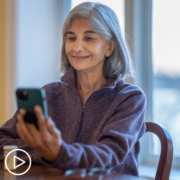Is Technology Accelerating Progress in Myeloproliferative Neoplasm Care?
Is Technology Accelerating Progress in Myeloproliferative Neoplasm Care? from Patient Empowerment Network on Vimeo.
Is myeloproliferative neoplasm (MPN) care being advanced by technology progress? Expert Dr. Krisstina Gowin from University of Arizona Cancer Center discusses how MPN care has benefited from technology advances and explains two MPN technology tools and how they assist in MPN patient care.
See More from MPN TelemEDucation
Related Resources:

How Can Myeloproliferative Neoplasm Patients Use Integrative Health? |

|

|
Transcript:
Lisa Hatfield:
So, Dr. Gowin, a couple of questions for you. Is technology playing a role in accelerating progress in MPN care?
Dr. Krisstina Gowin:
Oh, absolutely. And I think some of the ways that it really accelerates progress is pulling us together. So what we need to recognize is that myeloproliferative neoplasms truly is a rare disease, and we just celebrated Rare Disease Day. But there’s a lot of challenge in treating patients and progressing the field forward in rare diseases because you can’t do the big clinical trials. It’s hard to come together because everything’s siloed, and there’s just a couple patients here, a couple patients there in each practice. But with digital health and clinical trials that are offered on a digital platform, it pulls the nation together and even the world together. And we’ve seen that. I’ve done an international survey-based analysis and I had 858 MPN patients from 52 countries participate in that survey. And so that just shows how it pulls the world together. And for the web app that we just discussed, we had 93 patients say they were interested within three weeks, and within actually a week, we identified them all and then took three weeks to actually accrue them to the trial. So it really speaks to A, how MPN patients are digitally engaged and excited about these kinds of platforms. And then B, how effective it really can be to pull the groups together.
So yes, I think it’s…and that’s really how we’re going to get progress is through these kind of interventions with a rare disease. And I hope it’s okay if we jump back to something you said, Dr. Lopez, which is, I think telemedicine is so so important to bring everyone together. And in particular, I see that on the transplant ward. And so in myelofibrosis, that’s the only curative therapy. And so many myelofibrosis patients actually go through allogeneic stem cell transplantation. And my goodness, that is a socially isolating experience. Patients are in the hospital, not uncommonly for at least 30 days and then have to be near their transplant center for three months, which often is away from home. So to pull in their support system, both through the acuity of the transplant themselves and then the couple of months after is so crucial to a successful transplantation. And I think through FaceTime and also the MPN support groups, which is very robust, the patient advocacy and the way the MPN network sticks together on a digital platform, I think is really unique and offers unique support.
Lisa Hatfield:
Thank you. And then what role does technology play in the disease symptom management, and in particular, in clinical trials too. What role does technology play with clinical trials?
Dr. Krisstina Gowin:
Well, I think it helps us through different, clinical trial accrual patterns, we can see who’s eligible where, so it helps us identify patients. It helps us to, understand the different kind of precision-based medicine approaches so we can start to pool the data, say for, particular mutations… ASXL1 mutations. And so it helps us in the precision medicine aspect of clinical trials and now we’re looking at symptom management and how do we really integrate that. So large survivorship platforms like Carevive, if you’ve ever heard of Carevive, is now integrating our validated symptom assessment form into the Carevive platform. So now we can really collect that data and use that to mine it for potential kind of retrospective analysis. So it’s helpful for clinical trials as well as for our clinicians and clinics to really identify changes in symptom burden.
And just as Dr. Lopez was mentioning, that we can track these over time and it can flag and say, “Oh, your symptoms are changing, they’re increasing over time,” and maybe we need to be thinking about that. And so Carevive is really kind of an electronic medical record driven it’s really a healthcare driven platform, but now there’s patient ones too. And I just learned about this two weeks ago, I was at an MPN conference in Phoenix and learned about MPN Genie. And so MPN Genie apparently, is tracking…patients are putting their symptoms in and that’s shooting that information to the electronic medical record to their doctors. And so I think that’s fantastic, ’cause, we now get that information real time and we can change our clinical management, maybe bring that patient in sooner, maybe do a bone marrow earlier. We never would’ve identified that if it weren’t for those kind of digital engagements, so I think it’s a really exciting time. And I think we’re going to see more and more of these new platforms and ways for, different EMRs and smartphones to be communicating back and forth between patients and providers.
Share Your Feedback:
Create your own user feedback survey



